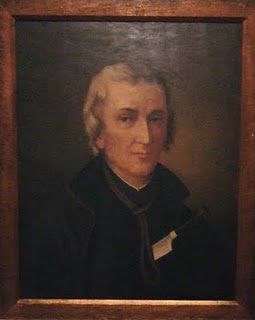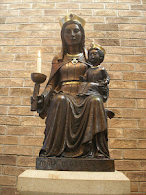 St John Houghton, the protomartyr of the English Reformation, was born in Essex in 1487. It is believed that he graduated from Cambridge University with degrees in civil and Canon Law. His minor gentry parents had arranged a very good marriage for him but John felt drawn to the priesthood. Because of their opposition to his choice, John had to go into hiding to pursue his vocation. He was prepared for ordination by a pious priest with whom he took lodging.
St John Houghton, the protomartyr of the English Reformation, was born in Essex in 1487. It is believed that he graduated from Cambridge University with degrees in civil and Canon Law. His minor gentry parents had arranged a very good marriage for him but John felt drawn to the priesthood. Because of their opposition to his choice, John had to go into hiding to pursue his vocation. He was prepared for ordination by a pious priest with whom he took lodging.After ordination John served as a parish priest for several years then he entered the Carthusian novitiate in London. About 1516 he was professed at the Charterhouse in London. For a short time John was prior of Beauvale Charterhouse in Northampton and then prior of the London Charterhouse.
Storm clouds gathered when, in 1534, King and Parliament decreed that all had to take an oath upholding the King’s marriage to Anne Boleyn and swearing that his marriage to Catherine of Aragon had been invalid. This was known as the Act of Succession because it obliged the oath-taker to acknowledge that Anne’s children would be the rightful and sole heirs to the throne. John Houghton refused to take the oath and he was arrested and imprisoned in the Tower of London. When the words “so far as it is lawful” were added to the decree, John felt able to take the oath, though still with some misgivings.
The situation worsened in 1535 when King Henry and Parliament introduced the Oath of Supremacy, which declared Henry to be the Supreme Head of the Church in England. Not to take the oath was deemed High Treason! For various reasons, (mostly terror of the tyrant King) some other orders and clergy acquiesced to this demand. Augustine Webster and Robert Lawrence, the Carthusian Priors of Axholme and Beauvale Charterhouses, travelled to London to discuss this state of affairs with John. Following three days of prayer, they contacted one of the King’s toadies, Thomas Cromwell, seeking exclusion, for themselves and the monks under them, from having to take the oath. The three were ordered to take the oath but they refused outright. On 20th April 1535 they were arrested and conveyed to the Tower, via Traitors’ Gate.
Under interrogation by Thomas Cromwell, John Houghton and his companions said that they were ready to consent to all that the law of God would permit. Cromwell, wanting total submission, declared; “I admit no exception. Whether the law of God permits it or no, you shall take the oath without any reserve whatsoever, and you shall observe it too.”
When the Carthusians pointed out that the Act was contrary to what the Catholic Church taught, Cromwell replied; “I care nothing for what the Church has held or taught. I will that you testify by solemn oath that you believe and firmly hold what we propose to you to profess; that the king is Head of the English Church.” The fate of the faithful monks was sealed!
The priests came to trial and twice the jury refused to condemn them, despite threats that if they failed to find in favour of the king they would suffer the same fate as the priests. It was only when Cromwell himself came in person and intimidated them that, for fear of their own lives, the cowed jury returned a guilty verdict against John Houghton and his companions. They were sentenced to be hanged, drawn, and quartered, the usual sentence for those convicted of High Treason.
On Tuesday, 4th May 1535, the condemned priests were dragged to Tyburn. John Houghton was the first of the *five to suffer, making him the protomartyr of the Reformation in England. The executioner begged his pardon and John embraced him. As he stood on the cart below the gallows, John was asked again to submit to the king before it was too late. The holy monk replied; “I call on Almighty God to witness, and I beseech all here present to attest for me on the dreadful danger of judgement, that, being about to die in public, I declare that I have refused to comply with the will of His Majesty the King, not from obstinacy, malice, or a rebellious spirit, but solely for fear of offending the Supreme Majesty of God. Our Holy Mother the Church has decreed and enjoined otherwise than the king and Parliament have decreed. I am therefore bound in conscience, and am ready and willing to suffer every kind of torture, rather than deny a doctrine of the Church. Pray for me, and have mercy on my brethren, of whom I have been the unworthy Prior.”
The barbaric sentence was carried out in full. The rope was placed around the martyr’s neck, the cart pulled away and he was left to hang but briefly. Then still alive and fully conscious, he was cut down and disembowelled. He was heard to exclaim; “Oh most holy Jesus, have mercy upon me in this hour!” Still alive as the executioner tried to rip his heart out, it was reported that the victim was heard to murmur; “Good Jesu, what will ye do with my heart?” John Houghton was then decapitated and his poor body quartered. His head was displayed on a pike on London Bridge and his quarters were hung in prominent places as a deterrent to any who would be so foolish as to question the wicked king and his contemptible Parliament. One quarter, including an arm, was suspended above the gate of the London Charterhouse. It was a most grisly and potent warning of things to come for, although John Houghton was the first, many more would follow.
On 9th December 1886, John Houghton was beatified by Pope Leo XIII. Eighty-four years later, on 25th October 1970, John Houghton was canonised by Pope Paul VI as one of the FORTY MARTYRS OF ENGLAND AND WALES.
*John Houghton and the two other Carthusian Priors, Augustine Webster and Robert Lawrence, were executed with Bridgettine monk, Richard Reynolds and secular priest, John Hale, who also refused to take the Oath of Supremacy.








.JPG)

.JPG)






Holy Martyrs Pray for Us!
ReplyDeleteHello Marion
ReplyDeleteIt is nice to hear from you. I am going away tomorrow & I will be gone about five weeks so I won't be doing any blogging for awhile. Thanks for looking in, keep in touch, and God bless you.
Hi Beth, I finally blogged about St. David Lewis from the book you sent me. Thank you so much for introducing me to a wonderfully devoted follower of Christ. May he intercede for us here in the United States as well as the U.K.! St. David Lewis, pray for us.
ReplyDeleteA friend of mine, goes to an Episcopalian Church nearby named after St. David Lewis. I would be curious to know the reasoning behind the selection of the name of this saint for their church. I will ask my friend to see if she knows and will let you know. I'm certain there are Catholic Churches in Wales and England named after St. David, right?
Best wishes to you and yours Breadgirl.
ReplyDeleteGod bless.
Hello Noreen
ReplyDeleteI am glad you found the book useful. I have looked in to your post & I will post a link to it.
I don't know the connection to St David Lewis & your friend's church but it is nice to know. You are right about churhes in Wales named after St David Lewis. I believe there are churches in the Philippines named after him too.
Thanks for your comments. God bless you & yours.
Hello Victor
ReplyDeleteHow are things with you? I hope all is well. It is always so very nice to hear from you. Take care & God bless you & your loved ones.